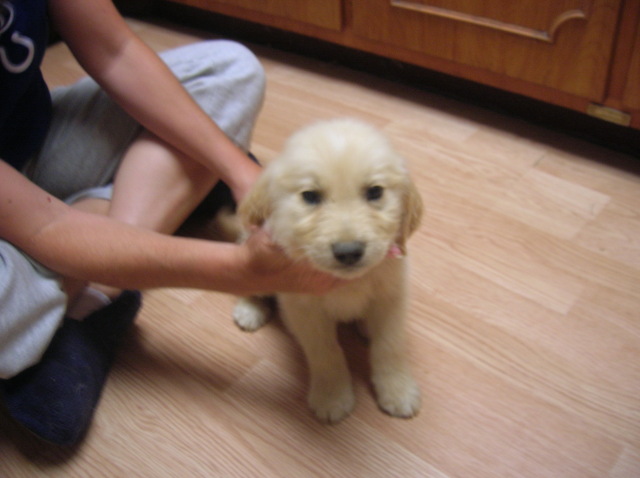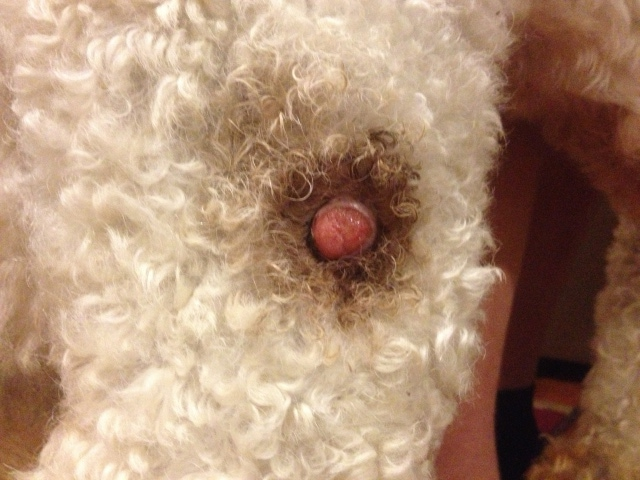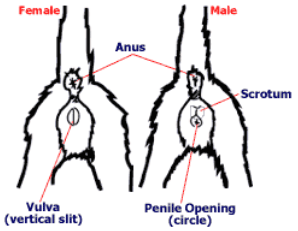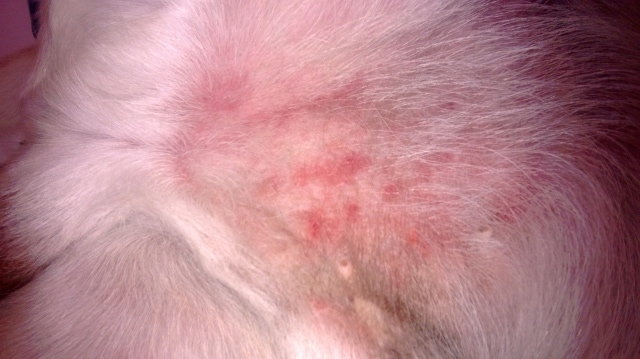Questioni have a 10 month old miniature poodle..i do take good care of him (Bob)real good...we were gonna nueter him but my daughter bought her a female miniature poodle,the puppy is 2 month old..and she wants to breed her with my poodle when she is ready to mate..my only concern is will i be doing my Poodle harm if i wait for him to wait,for the female poodle to come in heat to breed? and also my other question is...when do female poodles go into heat and when are they ready for mating..im new to this poodle stuff..our bob was given to us in march of this year as a gift..i hope you will give me good advice on what to do..i really want to breed my poodle with my daughters poodle when she is ready..i hope you can help me.. i do want this posted..maybe it will help others with simular questions.Sincerely,Dolores
AnswerDolores,
I do not recommend breeding pet poodles and really it should not be done by the novice. SPAY & NEUTER! Being a conscientious breeder means breeding to continually improve quality of the dogs, not for financial gain or for fun. The study of genetics is very important in selecting breeding dogs. Signs of an inherited diseases may not appear until your poodle is 3 to 7 years old. Anyone who owns a poodle should be familiar with these diseases, so symptoms are recognized early. Knowing the backgrounds of the bloodlines in your dog's pedigree is essential in order to do as much as possible to prevent genetic disorders--see the LARGE list below....
Blood Problems
Poodles are prone to two blood diseases. One involves the destruction of red blood cells, while the other affects the poodles blood-clotting ability. Both can be fatal.
Auto immune Hemolytic Anemia (AIHA)
A blood disease in which the body's own immune system destroys red blood cells. This destruction happens when antibodies stick to the red blood cells and the immune system attacks those antibodies. AIHA is a life-threatening disease, because without red blood cells, tissues aren't able to receive necessary oxygen. It may be triggered by toxins, cancers, drugs, a blood parasite, virus or even vaccinations, but exactly why it happens is not understood. Symptoms of AIHA include weakness, lethargy, pale gums, unusually dark urine, and yellow-tinged whites of the eye.
Von Willebrand's Disease (vWD)
A disorder that involves a tendency to bleed easily, is caused by a deficiency in the von Willebrand factor, a protein found in the blood plasma. You should suspect vWD if your dog has excessive and prolonged bleeding after injury or surgery, has visible blood in his urine or is bleeding from the nose or gums. Often a poodle with vWD has only mild symptoms and can lead very normal lives. You'll have to be especially careful your poodle doesn't get injured. Take care when trimming your poodles toenails and inform your groomer about the condition. Poodle-proofing your house by padding any sharp corners and any other hazards can help prevent injury.
Cushing's Disease
Cushing's Disease (canine hyperadrenocorticism) is a syndrome in which the body is producing too much cortisone. The cause is most often a small tumor in the pituitary gland, located in the brain. The symptoms of Cushing's Disease include: excessive consumption of water, increases frequency of urination, a ravenous appetite, hair loss, haircoat changes, and lethargy. Cushing's Disease typically affects middle-age to older dogs. There are several treatment options available.
Addison's Disease
A disorder caused by a deficiency in adrenocortical hormones. It occurs in all three poodle sizes but is most commonly seen in Standard females, 4 to 7 years of age. Symptoms include lethargy, weakness, vomiting, diarrhea, depression, eating poorly, anorexia and general physical deterioration. Symptoms will worsen under stress.
Left untreated, Addison's Disease is deadly. But once diagnosed the dog can be treated with daily or monthly medication to replace the hormones that the adrenal glands can't produce. A poodle that continues to take these hormones can live a long life, though he'll always be extra sensitive to stress.
Hypothyroidism
Low thyroid function is the most common endocrine problem in dogs. Auto immune thyroiditis, in which the thyroid is destroyed by the body's immune system, is genetic and is seen in all three varieties of poodles. It can lead to weight gain (without an increase in eating), a coarse, brittle coat that falls out, thickening and discoloration of the skin, lethargy, obesity, mental slowness and irregular heart rhythm. Hypothyroidism is fairly easily treated with medication that supplies the hormone that the body cannot make. The medication is given twice daily for the rest of the dogs life.
Eye Problems...There are more than TWENTY eye diseases that the poodle can inherit.
Progressive Retinal Atrophy
PRA is a family of, yet different diseases in which the retina gradually deteriorates, eventually causing blindness in all affected dogs. PRA typically shows up as night blindness when the poodle is 3 to 5 years old. His pupils will stay dilated and the eyes will shine. The dog will gradually become completely blind. If your poodle has PRA, keep lights on for him or use nightlights to help with the night blindness. After his vision is gone, take care not to change th layout of furniture or leave obstacles in his path. If you keep his environment consistent and use toys with bells or squeakers, you may notice little change in your poodle's demeanor, even after he has lost his sight.
Progressive Iris Atrophy
Like PRA, this is a progressive type disease that causes the iris to shrivel and die resulting in blindness.
Juvenile Cataracts
Cataracts that are inherited are called Juvenile Cataracts. Cataracts cause the lens of the eyes to cloud over, blocking light to the retina and affecting the vision. Severe cases lead to blindness.
If you see signs of vision impairment in your poodle (umping into things, hesitancy to jump onto or off furniture) or the characteristic bluish white cloudiness over the eye, take him to the veterinarian. If your poodles cataracts are inherited, they might be able to be removed surgically. A cataract can also occur secondary to another condition, like diabetes, so it's important to catch them early and address any other related conditions.
Epiphora (Excessive Tearing)
All sizes of Poodles are prone to epiphora. This is often obvious by the stains that are seen starting from the inside corner of the eyes and running down the face. Epiphora can happen on its own or be the result of distichiasis (extra row of eyelashes) or entropion (eyelashes become tucked under the eyelid and irritate the eyeball). If your Poodle suddenly develops this condition, it is best to have him or her checked out by your veterinarian to rule out these disorders, corneal ulcerations or some type of eye trauma. Miniature and Toy Poodles sometimes have an absence of the opening at the lacrimal canal (tear duct). This condition is called nasolacrimal puncta atresia.
Idiopathic Epilepsy
A neurological disorder marked by recurring seizures, abnormal discharges of electrical impulses by nerve cells in the brain. As in humans, it is controlled with drugs. Since these drugs can have long-term side affects, your veterinarian may first monitor your poodle to make sure the seizures are regular and severe enough to warrant treatment. If your poodle has a seizure that lasts longer than 5 to 10 minutes, or has 3 or more seizures in a single day, seek veterinary help immediately.
Juvenile Renal Disease (JRD)
Chronic kidney failure is typically a disease of older dogs - their kidneys simply wear out. But dogs with JRD lose kidney function very early, often when they are less than a year old. JRD is an inherited condition seen in Standard Poodles. There is no cure - the kidneys will inevitably fail. But the earlier is caught, the more there is that can be done to slow the decline. Signs of Juvenile Renal Disease include increased thirst, urination, leaking urine and weight loss. Because of increased urination, puppies with JRD are hard to housetrain.
Orthopedic Problems
Problems with your poodles bones can be very painful. Poodles of all sizes are susceptible to hip dysplasia while Miniatures and Toys are also susceptible to Legg-Calve-Perthes disease and patellar luxation.
Hip Dysplasia
A condition in which the head of the femur fits improperly into the hip joint socket, causing pain and lameness. Pain killers and/or surgery are the usual treatments. Being a large dog, the Standard Poodle is more likely to suffer from Hip Dysplasia, though it can affect Miniatures and Toys. Symptoms include decreased activity, stiffness, lameness, a swaggering gait, muscle wasting in thighs, unwillingness to jump or stand on the hind legs and soreness after lying down. It is important to keep your poodles weight to a healthy low level to help alleviate pressure on the hips.
Legg-Calve-Perthes (LCP)
A painful hip disease in which the cap of the femur bone in the hip suffers a loss of blood supply. This leads to deterioration of the femoral head and eventually it no longer fits properly in the socket. This is painful and the dog becomes lame on that leg. Dogs start showing early symptoms of LCP - limping, favoring one leg, or walking with a strange gait - when they are under a year old. Anti-inflammatory drugs and/or surgery are the usual treatments.
Patella Sub-luxation
Slipped kneecap, a condition in which the patella (located at the joint of the hind leg) slides in and out of the groove where it is normally held in place by ligaments. It can occur in one or both knees and can show up in Toy and Miniature puppies as young as 8 weeks, though the problem can occur later in life. A poodle with luxating patella will stand funny appearing bow-legged. He may cry out because of the pain and straighten his leg in an effort to put it back in place or he may hold it up. He may walk with a hitch in his gait. Depending on the severity of the luxation and the age of the dog, surgery may be required.
Sebaceous Adenitis (SA)
A chronic skin disorder that affects all three sizes of Poodles-most common in the Standard Poodle, resulting in abnormal, inflamed, or absence of, sebaceous glands. Symptoms may include excessive dandruff, scaling, darkened skin, thickened skin, a silvery scaling of the skin, a musty, unpleasant odor, and hair loss. SA can show up when the poodle as young as 18 months or as old as 9 years. Diagnosing SA is done with a skin biopsy. Statistic show that as many as 50 percent of all Standard Poodles are carriers or affected. There is no cure. Therapeutic baths and antibiotics for secondary skin infections are the recommended treatments.
IN CONCLUSION, LET THE PROFESSIONALS DO THE BREEDING UNLESS YOU WANT TO RISK THE PUPPIES GETTING ANY OF THE ABOVE DISEASES.

 Impossible allergies
Question
Belly
I rescued a male cat several years ago.
Impossible allergies
Question
Belly
I rescued a male cat several years ago.
 thank god for your sweet heart
QuestionRiley
QUESTION: i feel so much better an
thank god for your sweet heart
QuestionRiley
QUESTION: i feel so much better an
 Growth on standard poodle rear leg
Question
Standard poodle growth
Hello,
My female
Growth on standard poodle rear leg
Question
Standard poodle growth
Hello,
My female
 kitten not using litter box, but sleeps in it
QuestionHi. We just got a new kitten. It is 9 weeks old
kitten not using litter box, but sleeps in it
QuestionHi. We just got a new kitten. It is 9 weeks old
 Red Rashes all over his body
Question
Red Rash Red Rash
My pet had red
Red Rashes all over his body
Question
Red Rash Red Rash
My pet had red